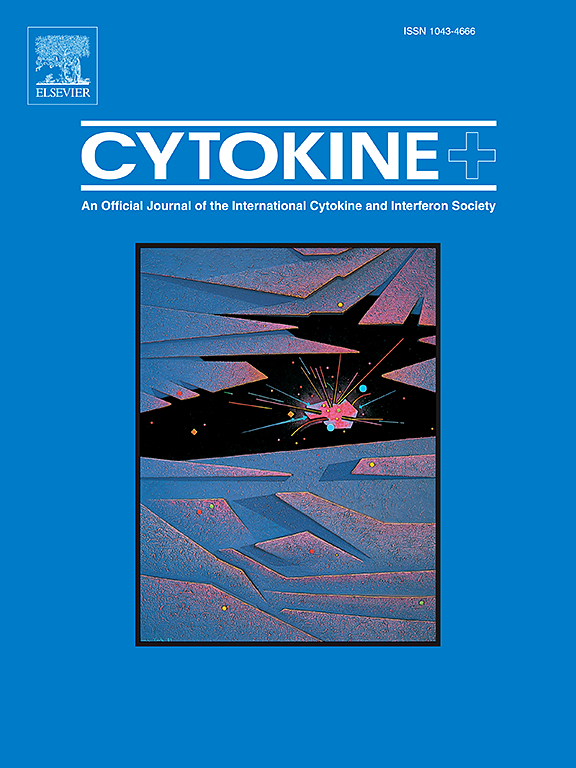血清白细胞介素-1受体拮抗剂水平是大血管炎疾病活动性和复发风险的有用标志物。
IF 3.7
3区 医学
Q2 BIOCHEMISTRY & MOLECULAR BIOLOGY
引用次数: 0
摘要
目的:探讨血清白细胞介素-1β (IL-1β)或IL-1受体拮抗剂(IL-1Ra)水平是否与巨细胞动脉炎(GCA)和高松动脉炎(TAK)等大血管炎(LVV)的疾病活动性或复发风险相关。方法:21例初治期LVV活动性患者(GCA 13例,TAK 8例)和14例健康人纳入研究。检测血清IL-1β、IL-1Ra、IL-2、IL-6、IL-12p40、IL-17、IL-23、IFN-γ、TNF-α水平。分析其与c反应蛋白(CRP)水平、印度Takayasu临床活动评分(ITAS-A)和复发的关系。结果:TAK患者IL-1Ra水平(465.3 pg/mL)和GCA患者IL-1Ra水平(384.9 pg/mL)明显高于健康人(170.4 pg/mL); p340.4 pg/mL可以区分非复发和复发病例(AUC = 0.95)。结论:血清IL-1Ra水平与GCA患者CRP水平和TAK患者ITAS-A评分相关,可作为预测复发的生物标志物。本文章由计算机程序翻译,如有差异,请以英文原文为准。

Serum interleukin-1 receptor antagonist levels are a useful marker of disease activity and risk of relapse in large vessel vasculitis.
Objective
To examine whether serum interleukin-1β (IL-1β) or IL-1 receptor antagonist (IL-1Ra) levels are associated with disease activity or relapse risk in large vessel vasculitis (LVV), including giant cell arteritis (GCA) and Takayasu arteritis (TAK).
Methods
Twenty one patients with treatment-naive, active LVV (13 with GCA and 8 with TAK), and 14 healthy individuals were enrolled in the study. Serum levels of IL-1β, IL-1Ra, IL-2, IL-6, IL-12p40, IL-17, IL-23, IFN-γ, and TNF-α were measured. Association with C-reactive protein (CRP) levels, Indian Takayasu clinical activity score (ITAS-A), and relapse were analyzed.
Results
IL-1Ra levels were significantly higher in patients with with TAK (465.3 pg/mL) and GCA (384.9 pg/mL) compared to healthy individuals (170.4 pg/mL; p < 0.001). IL-6 levels were also elevated in LVV, while IL-1β and IFN-γ were increased only in GCA and IL-17 levels were increased only in TAK. IL-1Ra levels positively correlated with ITAS-A scores in TAK and with CRP levels in GCA. IL-6 correlated with CRP in both diseases; IL-1β and other cytokines showed no such association. During follow-up, six patients (five with GCA and one with TAK) experienced symptomatic relapse. In GCA, baseline IL-1Ra levels were significantly lower in those who relapsed compared to non-relapsed patients (270.8 vs. 616.4 pg/mL; p = 0.008). No significant difference in other cytokine levels were observed. Receiver operating characteristic analysis demonstrated that IL-1Ra levels >340.4 pg/mL could distinguish non-relapsed from relapsed cases (AUC = 0.95).
Conclusion
Serum IL-1Ra levels correlate with CRP levels in GCA and ITAS-A scores in TAK and serve as a predictive biomarker for relapse.
求助全文
通过发布文献求助,成功后即可免费获取论文全文。
去求助
来源期刊

Cytokine
医学-免疫学
CiteScore
7.60
自引率
2.60%
发文量
262
审稿时长
48 days
期刊介绍:
The journal Cytokine has an open access mirror journal Cytokine: X, sharing the same aims and scope, editorial team, submission system and rigorous peer review.
* Devoted exclusively to the study of the molecular biology, genetics, biochemistry, immunology, genome-wide association studies, pathobiology, diagnostic and clinical applications of all known interleukins, hematopoietic factors, growth factors, cytotoxins, interferons, new cytokines, and chemokines, Cytokine provides comprehensive coverage of cytokines and their mechanisms of actions, 12 times a year by publishing original high quality refereed scientific papers from prominent investigators in both the academic and industrial sectors.
We will publish 3 major types of manuscripts:
1) Original manuscripts describing research results.
2) Basic and clinical reviews describing cytokine actions and regulation.
3) Short commentaries/perspectives on recently published aspects of cytokines, pathogenesis and clinical results.
 求助内容:
求助内容: 应助结果提醒方式:
应助结果提醒方式:


